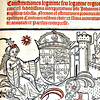
Steps towards creating a Minnesota territory began in the 29th Congress, 1846-47. Morgan Martin, a Wisconsin delegate, introduced a bill in the House of Representatives to create a Minnesota territory. The bill was not passed.
The following year, 1848, the people of the Minnesota territory chose General H.H. Sibley to represent them in Washington, D.C. He encountered difficulties being accepted as a delegate because he was technically from the state of Wisconsin, which was already fully represented in both houses of Congress. He was eventually given a seat in the House of Representatives on January 15, 1849.
During the debate of the bill to make Minnesota a territory, many representatives displayed a significant lack of knowledge about the area. Some thought the land was ill-suited for agriculture and a place �where no white man would go unless to cut pine logs.� Others were disappointed that General Sibley was �if not in full Indian costume, at least with some peculiarity of dress and manners characteristic of the rude and semi-civilized people who sent him to the capitol.� (Compendium of History and Biography of Northern Minnesota, 1902 at 52).
Despite their ignorance, the bill passed. After considering the names Algonquin, Itaska, Chippewa, and Washington for the new territory, Minnesota became a territory on March 3, 1849.
[Washington], 1848



![Abridgement of cases to the end of Henry VI [1460]](/_ui/img/treasures/img/thumbs/Picture2.png)





















